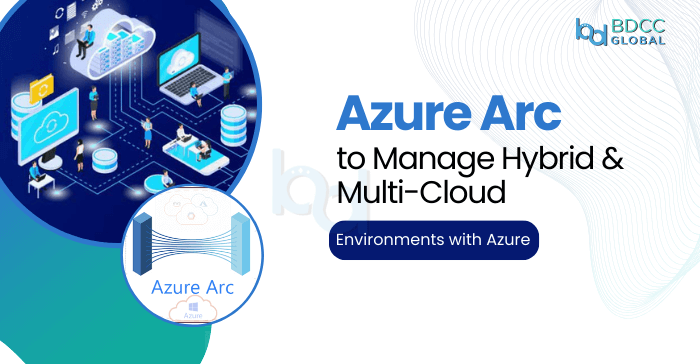
According to a recent Flexera State of the Cloud report, 89% of enterprises now adopt a multi-cloud strategy, and over 80% still run workloads on-premises. The reality? The cloud isn’t a destination anymore—it’s a complex ecosystem of platforms, providers, and edge devices.
And with that complexity comes chaos: fragmented governance, inconsistent security, and a constant juggling act across environments.
This is exactly where Azure Arc steps in.
Azure Arc isn’t about pushing everything into Azure—it’s about meeting you where you are. Whether your workloads run in AWS, GCP, on-prem, or even at the edge, Azure Arc helps you manage them as if they were native Azure resources. Same policies. Same security. Same visibility.
In short? It’s about extending Azure services to everything else.
Also read: How Azure Consultants Help Businesses Leverage Data
Understanding Azure Arc in the Hybrid Cloud with Azure Era
Azure Arc is Microsoft’s hybrid and multi-cloud management platform. It allows organizations to project their non-Azure infrastructure into the Azure ecosystem—providing a single, centralized interface to manage resources across diverse environments.
It works by extending Azure services and Azure Resource Manager (ARM) capabilities to:
- On-premises Windows and Linux servers
- Kubernetes clusters (on-prem or hosted)
- SQL Servers
- Azure Stack HCI and VMware vSphere
- Multi-cloud environments (AWS, GCP)
- Edge devices in disconnected or remote locations
Once onboarded, these resources are no longer isolated or managed through fragmented tools. They inherit the full lifecycle capabilities of Azure—like RBAC, tagging, policy enforcement, security recommendations, and logging—without the need to migrate or refactor the workloads. This is the essence of a true Azure hybrid cloud solution.
Why Are Enterprises Turning to Azure Arc?
The reasons are mentioned below for a better understanding:
Navigating Infrastructure Sprawl
As organizations adopt containers, edge computing, and multi-cloud strategies, infrastructure sprawl becomes a real operational burden. Azure Arc acts as a management abstraction layer—helping teams bring structure and visibility to complex environments.
Centralized Security and Compliance
With Azure Arc, you can enforce:
- Identity management via Azure Active Directory
- Compliance policies through Azure Policy
- Security baselines with Defender for Cloud
- Log and alert unification through Azure Monitor and Log Analytics
Even if your VM is running in a local datacenter or a Kubernetes cluster in GCP, Arc enables the same enterprise-grade controls you apply in Azure. That’s what makes Azure Arc for multi-cloud governance so effective.
Accelerated DevOps and GitOps
Arc supports infrastructure-as-code and GitOps workflows using Flux. This is especially useful for Kubernetes clusters—where you can automatically sync configurations and deployments from a Git repo, ensuring drift-free environments across regions.
Under the Hood: How Azure Arc Works
Azure Arc’s architecture is built around the concept of extending ARM to register external resources. When a resource like a server or Kubernetes cluster is Arc-enabled, it appears in the Azure portal just like any native Azure resource.
Connected Machine Agent for Servers
For Windows and Linux VMs that run outside of Azure, Azure Arc uses the Azure Connected Machine agent. This lightweight agent establishes a secure connection to Azure and allows the machine to appear in Azure as a hybrid compute resource.
That means you can apply tags, assign RBAC roles, evaluate compliance via Azure Policy, and monitor performance—just like you would with any cloud-native resource. The best part? No rehosting. No changes to the existing environment.
Kubernetes Integration
Azure Arc integrates with any CNCF-compliant Kubernetes cluster—on-prem or in AWS, GCP, or even edge devices. Helm-based deployments allow Azure to register and manage these clusters as if they were native.
From there, you can push GitOps-based configurations using Azure Kubernetes Configuration, enforce policy, enable Azure Monitor for Containers, and secure everything with Defender for Containers. This is the cornerstone of a seamless Azure hybrid cloud solution.
SQL and Data Services
You’re not limited to compute and containers. With Azure Arc, you can onboard SQL Server instances and enable insights, backups, and vulnerability assessments—directly from Azure.
For regulated industries or disconnected edge environments, Arc-enabled data services let you deploy Azure SQL Managed Instance or PostgreSQL on Kubernetes, outside of Azure, but with the same management experience. This is a prime use case of extending Azure services to where the data actually resides.
Architecture Deep Dive
Here’s a conceptual overview of how Azure Arc interacts with external environments:

Once resources are connected, they appear in the Azure Portal or via ARM templates like any native Azure resource.
Real-World Scenario: Managing Kubernetes at the Edge
Let’s consider a global retail chain with over 1,000 physical locations. Each store has its own on-prem Kubernetes cluster running point-of-sale and inventory apps. These can’t be moved to the cloud due to latency and offline reliability needs. Meanwhile, the headquarters operates analytics and ERP systems in Azure and AWS.
Before Azure Arc, this setup meant managing hundreds of clusters manually. Updates were inconsistent, compliance patchy, and observability minimal.
With Azure Arc, each store’s cluster is Arc-enabled and GitOps-managed. Compliance policies are enforced uniformly. Logs and metrics flow into Azure Monitor. Defender scans each workload. Operationally, the company now runs a hybrid architecture with centralized control—a textbook case of hybrid cloud with Azure done right.
When Should You Use Azure Arc?
Azure Arc is ideal when:
- You operate in regulated industries where data must stay on-prem
- You have a distributed edge infrastructure
- You run services across Azure, AWS, and GCP
- You want a unified policy and security layer
- You need consistency across environments without refactoring everything
It brings the cloud management plane to you—not the other way around.
Whether you’re looking to implement Azure hybrid cloud solutions, gain visibility across providers, or streamline DevOps pipelines across clusters, Azure Arc for multi-cloud gives you the tools to do it.
Final Thoughts
Today’s enterprise environments are hybrid by design and multi-cloud by necessity. The only way to tame this complexity is through unification—not fragmentation.
Azure Arc delivers exactly that: a single control plane to govern, secure, monitor, and automate infrastructure—no matter where it runs.
In a world where extending Azure services across physical and cloud boundaries is a business imperative, Azure Arc doesn’t just help—it transforms.
BDCC
Latest posts by BDCC (see all)
- Why Golang is Becoming the Go-To Language for DevOps Engineers - April 11, 2025
- Azure Arc: Extending Azure Services to Hybrid and Multi-Cloud Environments - April 8, 2025
- How AI Is Reshaping DevSecOps Governance - April 4, 2025

